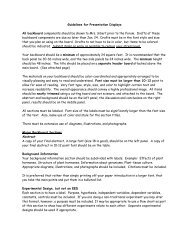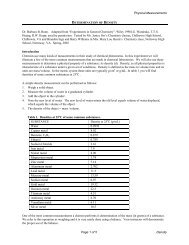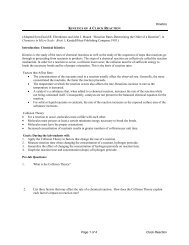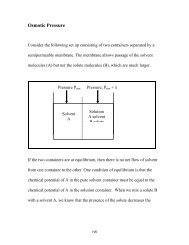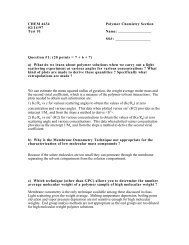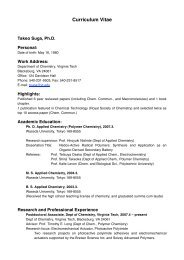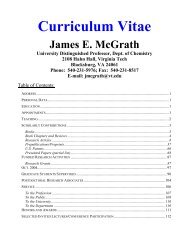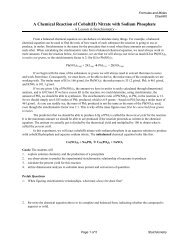Carlier Group Gaussian User Manual - Virginia Tech
Carlier Group Gaussian User Manual - Virginia Tech
Carlier Group Gaussian User Manual - Virginia Tech
Create successful ePaper yourself
Turn your PDF publications into a flip-book with our unique Google optimized e-Paper software.
<strong>Carlier</strong> <strong>Group</strong> <strong>Gaussian</strong> <strong>User</strong> <strong>Manual</strong> 33<br />
# rb3lyp/6-31g(d) SCRF=(Dipole, Dielectric=7.58, a0=6.63, Solvent=thf)<br />
where SCRF (Self-Consistent Reaction Field) for Onsager calculations is Dipole, the<br />
dielectric constant has to be specified (<strong>Gaussian</strong> has values for a number of solvents in<br />
their user manual), and the solvent (in this case - THF) is also specified. The average<br />
radius a 0 can be obtained by the method described above.<br />
The energy output looks like the output obtained from an energy calculation in vacuum<br />
and can be obtained using the following command:<br />
egrep SCF filename.out<br />
Onsager optimizations are performed the same way with the addition of opt and freq<br />
options in the route line as follows:<br />
# rb3lyp/6-31g(d) SCRF=(Dipole, Dielectric=7.58, a 0 =6.63, Solvent=thf)<br />
opt freq<br />
Onsager calculations can be performed with DFT and HF methods. However, in<br />
<strong>Gaussian</strong> 03, they could not be performed using the MP2 method.<br />
Polarized Continuum Model (PCM):<br />
As mentioned earlier, the other solvation model that is frequently used is the<br />
PCM. Unlike in the case of the Onsager model, the PCM comes with the option of<br />
predesigned cavities, owing to which there are no fluctuations associated with the<br />
energies obtained. There are several different flavors of PCM (i.e. CPCM, SCI-PCM);<br />
but in <strong>Gaussian</strong>03 with our typically large molecules, we have had luck only with PCM<br />
itself.<br />
UA0: This is the default radius in <strong>Gaussian</strong>03. In this model, the hydrogens are<br />
incorporated in the spherical cavities of the heavy atom they are bonded to.<br />
Bondi: Uses the Bondi atomic radii for all atoms and treats hydrogens explicitly.<br />
Pauling: Uses the Pauling atomic radii for all atoms and treats hydrogens explicitly. Is<br />
recommended for ionic molecules.<br />
Note: The new default for <strong>Gaussian</strong> 09 is UFF (Universal Force Field), and has explicit<br />
hydrogens unlike UA0. We have not used this yet.<br />
We have used the default settings, as well Bondi and Pauling radii with great success.<br />
In some cases where Bondi has failed in generation of the cavity, Pauling has been<br />
applied successfully.



